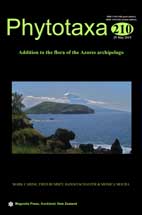Abstract
Using the moss genus Rhynchostegiella (Brachytheciaceae) as a model, we address the question of whether taxonomic shortcomings account for the extremely low rates of endemism reported in the Azorean bryophyte flora. Eight accessions initially assigned to three of the four previously reported species in the Azores were identified as a distinct species using the Generalized Mixed Yule Coalescent method in the context of a molecular phylogenetic analysis of the genus. Rhynchostegiella azorica sp. nov. is therefore described as a new species that is endemic to the Azores. Its morphological features intergrade with those observed in other species, with a seta that ranges from almost smooth to rough; a length to width ratio of the laminal cells that matches the one of the R. curviseta group; but a leaf apex that is typical of the R. tenella group. This suggests that previous reports of four Rhynchostegiella species from Azores are erroneous and that a single, morphologically variable species, R. azorica, occurs in the archipelago. Rhynchostegiella azorica is sister to the remainder of the species of the genus, whose most recent common ancestor was dated at 4–20 Ma. This points to a more ancient origin in comparison with other Macaronesian endemic species of the genus. The unexpected discovery of an Azorean endemic species in Rhynchostegiella suggests that patterns of endemicity in the Azorean bryophyte flora are not well estimated from traditional taxonomic knowledge and point to the necessity of an extensive integrative taxonomic revision.

